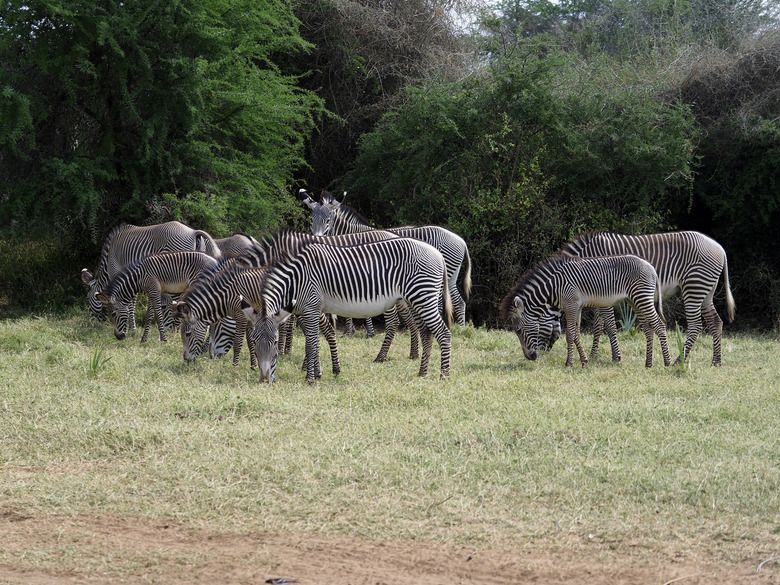Zebra Life Cycle
Zebras are African equine species known for their white fur with black or dark brown stripes. This equine species maintain close-knit social behaviors since they are more likely to survive in the wild if they are grouped together. The gestation periods and lifespans of zebras are different among subspecies. According to Zoo Atlanta, the four primary zebra species are Cape mountain, Hartmann's mountain, plains and the Grevy's zebras.
Gestation
One of the longest gestation periods of zebra subspecies belongs to the Grevy's zebra. The average Grevy's gestation period ranges from 358 to 438 days, or 12 to 14 months. The plains zebra's gestation period is approximately 360 to 396 days, or 12 to 13 months. Most zebras deliver single birth, but have also been known for producing twins, according to the University of California-San Diego. However, twin birth usually results in only one of the newborns surviving. Newborn zebras are known as foals.
A male zebra, or a stallion, is the head of all zebra subspecies family structures. A group of mares, or female zebras, accompanies the stallion. The group of females is known as a harem, and a common harem has between two to four mares. Stallions acquire mares by fighting other stallions when they are young; young female zebras are fillies. Stallion fights are violent and include kicking and biting. When a new filly enters the zebra group, animosity may exist between the new female and the other mares. The stallion's responsibility is to find grazing areas and watering holes for the harem.
Predation
Zebras are herbivorous, meaning they only eat vegetation. However, these equines are the targets of carnivorous animals, such as leopards, hyenas and lions. To avoid predation, zebras take turns sleeping. Usually two or three zebras will remain awake while the other zebras sleep. During the day, zebras will stand in a group and their stripes make it difficult for predators to decide which zebra to chase. The width of the zebra's stripes vary among subspecies. According to the San Diego Zoo, zebras in southern Africa have wider stripes than zebras in central Africa's grasslands.
Conservation
In the wild, a zebra's natural life span ranges between 28 and 30 years, depending on the species. However, over 50-percent of foals are taken by predators and two zebra species, the Grevy's and Cape mountain, are on the verge of extinction. The primary reasons for these zebras' endangerment is over-hunting for fur, habitat destruction and loss of water resources, according the International Union for Conservation of Nature's Red List. Several organizations, such as the Grevy's Zebra Trust and Darwin Zebra Conservation Project raise awareness to ensure the survival of these African equines.
Cite This Article
MLA
Davis, Skip. "Zebra Life Cycle" sciencing.com, https://www.sciencing.com/zebra-life-cycle-8609398/. 22 November 2019.
APA
Davis, Skip. (2019, November 22). Zebra Life Cycle. sciencing.com. Retrieved from https://www.sciencing.com/zebra-life-cycle-8609398/
Chicago
Davis, Skip. Zebra Life Cycle last modified August 30, 2022. https://www.sciencing.com/zebra-life-cycle-8609398/
